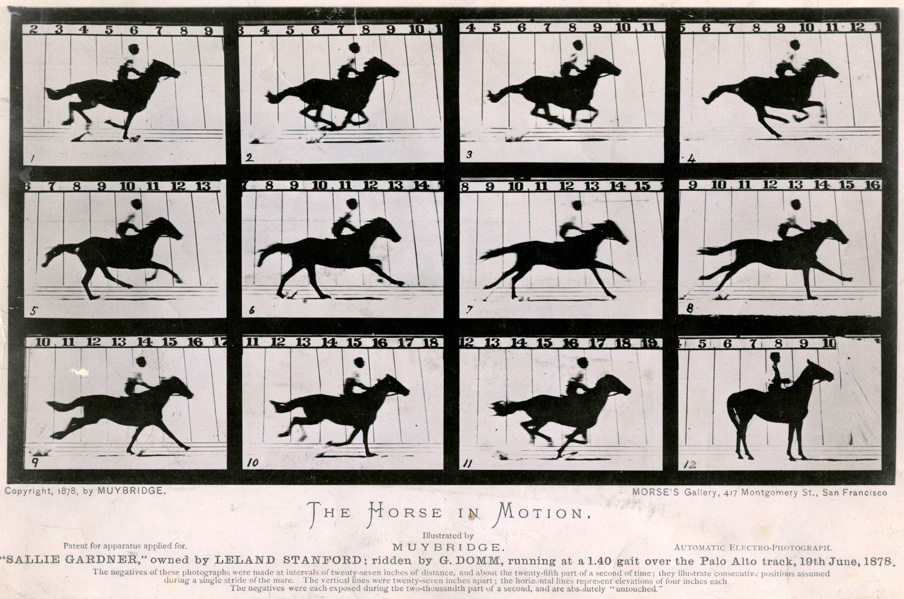California Stories

English Label
Eadweard Muybridge, United States, born United Kingdom, 1830-1904
The Horse in Motion (Sallie Gardner), 1878 (printed later)
Gelatin silver print
“In 1872, Leland Stanford, former governor of California and president of the Central Pacific Railroad, asked Eadweard Muybridge to photograph a horse galloping at full speed. This simple request, intended to confirm Stanford’s theory that all of the horse’s feet were off the ground simultaneously at some point during its stride, launched Muybridge on a lifelong pursuit to record animals in motion.” – The Metropolitan Museum of Art
The horse in motion project was interrupted, however, when Muybridge shot his wife’s lover at point-blank range at a party in Calistoga in 1874. He was tried for murder, but the jury, against the judge’s admonitions, found the killing justified and Muybridge was freed. Following the trial, to help Muybridge regain his strength, Stanford sent him on a photographic excursion to Central and South America. While Muybridge was gone, his wife died unexpectedly at age 24.
In 1877, by placing a series of cameras with strings to trip the shutters, Muybridge was able to prove that Stanford’s horse, Occident, did indeed leave the ground completely. Later, on June 19th, 1878, he photographed another of Stanford’s horses, Sallie Gardner, again proving the point and producing a clearer image of the action.
Muybridge continued his studies with the encouragement of painter Thomas Eakins, who introduced him to the University of Pennsylvania. Trustees at the university and wealthy patrons helped fund Animal Locomotion, the first extensive scientific study to be based upon photography. The project consisted of 781 plates of humans and animals in various positions of movement.
Spanish Label
Eadweard Muybridge, Estados Unidos, nacido en el Reino Unido, 1830-1904
The Horse in Motion (Sallie Gardner) [Caballos en movimiento (Sallie Gardner)], 1878 (impreso más tarde)
Impreso en gelatina de plata
“En 1872, Leland Stanford, ex gobernador de California y presidente del Central Pacific Railroad [Ferrocarril Central Pacífico], le pidió a Eadweard Muybridge que fotografiara a un caballo galopando a toda velocidad. Este simple pedido, con la intención de probar la teoría de Stanford de que todas las patas del caballo se encontraban en el aire simultáneamente en algún momento del galope, envió a Muybridge en una búsqueda eterna para lograr registrar a animales en movimiento”. – The Metropolitan Museum of Art
Sin embargo, el proyecto del caballo en movimiento se vio interrumpido cuando Muybridge le disparó al amante de su esposa a boca jarro en una fiesta en Calistoga en 1874. Fue enjuiciado por asesinato, pero el jurado, contrario a las recomendaciones del juez, encontró el asesinato justificado y Muybridge fue liberado. Después del juicio, para ayudar a Muybridge a retomar su fuerza, Stanford lo envió en una excursión fotográfica a Centro y Sudamérica. En su ausencia, su esposa murió inesperadamente a los 24 años de edad.
En 1877, ubicando una serie de cámaras con cuerdas para activar los disparadores, Muybridge logró probar que el caballo de Stanford, Occident, sí se elevaba completamente del suelo. Más tarde, el 19 de junio de 1878, fotografió a otro de los caballos de Stanford, Sallie Gardner, una vez más probando el punto y produciendo una imagen más clara de la acción.
Muybridge continuó sus estudios con el apoyo del pintor Thomas Eakins, quien lo presentó en la Universidad de Pennsylvania. Regentes de la universidad y acaudalados patrocinadores ayudaron a financiar Animal Locomotion [Locomoción animal], el primer estudio científico extenso basado en la fotografía. El proyecto consistió de 781 placas de humanos y animales en varias posiciones de movimiento.

